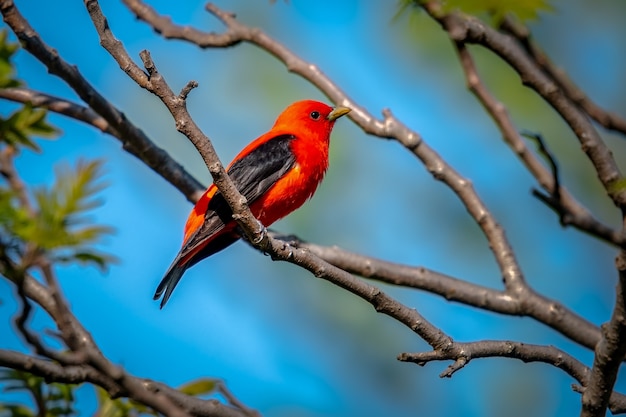Table of Contents
ToggleIntroduction
Florida’s diverse avian population is a captivating subject for bird enthusiasts. Small red birds stand out as vibrant symbols of nature’s beauty among the myriad of feathered wonders. In this article, we delve into the world of these tiny crimson creatures, exploring their characteristics, habitats, and the joy they bring to birdwatchers.
Florida’s Avian Diversity
Florida boasts an impressive variety of bird species, making it a haven for birdwatchers. Small red birds, a unique subset of this avian tapestry, add color to the state’s rich biodiversity. Identifying these birds becomes an exciting challenge for both seasoned and amateur birdwatchers.
Identification Characteristics
Small red birds exhibit distinctive physical traits that make them easily recognizable. From the brilliant red plumage to specific markings, understanding these characteristics enhances the birdwatching experience. Whether you’re spotting a cardinal, a vermillion flycatcher, or a summer tanager, the identification process becomes rewarding.
Common Small Red Birds in Florida
Cardinal: The Vibrant Red Icon
One of the most iconic small red birds in Florida is the cardinal. Its striking red hue and crested head make it a favorite among birdwatchers. Cardinals are common in gardens and wooded areas, adding a burst of color to their surroundings.
Vermilion Flycatcher: A Splash of Color
With its vibrant red plumage and agile aerial maneuvers, the vermillion flycatcher is a spectacle in flight. This tiny bird’s stunning appearance and unique hunting style make it a sought-after sighting for bird enthusiasts.
Summer Tanager: A Seasonal Visitor
As the name suggests, the summer tanager graces Florida with its presence during the warmer months. Its all-red plumage distinguishes it from other tanagers, creating a visual feast for birdwatchers lucky enough to spot this seasonal visitor.
Habitats and Behavior
Understanding small red birds’ preferred habitats and behavior enhances the likelihood of successful birdwatching. These birds often inhabit wooded areas, gardens, and parks. Observing their behavior, such as feeding patterns and mating rituals, adds depth to the birdwatching experience.
Attracting Small Red Birds to Your Garden
For enthusiasts looking to create a bird-friendly space, specific strategies can attract small red birds. Providing suitable feed, installing birdhouses, and cultivating native plants effectively make your garden a haven for these colorful creatures.
Challenges for Small Red Birds
While these birds contribute to Florida’s natural beauty, they face biological threats and human activities challenges. Conservation efforts are crucial to ensuring the region’s continued existence of small red bird species.
Birdwatching Hotspots in Florida
Florida offers numerous hotspots for birdwatching, where enthusiasts can observe small red birds in their natural habitats. Local communities often organize birdwatching events, fostering a sense of camaraderie among birdwatchers.
The Joy of Birdwatching
Personal experiences in birdwatching often transcend the simple act of observation. The joy derived from connecting with nature and witnessing the beauty of small red birds is a testament to the therapeutic benefits of this recreational activity.
Tips for Amateur Birdwatchers
Aspiring birdwatchers should equip themselves with essential tools and techniques. Patience, keen observation, and proper equipment are critical elements in spotting and appreciating small red birds in their natural habitats.
Educational Resources
Online platforms and local birdwatching groups provide valuable resources for learning more about Florida’s bird species. Engaging with these communities enhances knowledge and fosters a deeper appreciation for the avian wonders of the region.
Photography Tips for Birdwatchers
Capturing the beauty of small red birds through photography requires skill and ethical considerations. Birdwatchers turned photographers should prioritize the well-being of the birds and adhere to responsible practices in their pursuit of stunning avian images.
Connecting with Fellow Bird Enthusiasts
The advent of social media has facilitated connections among birdwatching enthusiasts. Joining online groups and forums allows individuals to share experiences, insights, and tips, fostering a sense of community among bird enthusiasts.
Conservation Awareness
Preserving the habitats of small red birds is paramount for their survival. Birdwatchers can actively participate in conservation initiatives, protecting these beautiful creatures and their ecosystems.
Conclusion
In conclusion, small red birds in Florida are not just winged wonders but ambassadors of nature’s brilliance. Engaging with these creatures through birdwatching provides entertainment and instills a sense of responsibility toward their conservation. So, grab your binoculars, head to the nearest birding hotspot, and immerse yourself in the colorful avian tapestry of Florida.
FAQs
- How can I attract small red birds to my garden?
Providing suitable feed, installing birdhouses, and cultivating native plants can attract small red birds to your garden.
- What are the typical small red birds in Florida?
Cardinal, vermillion flycatcher, and summer tanager are among Florida’s common small red birds.
- Are there specific birdwatching hotspots in Florida?
Florida has numerous birdwatching hotspots where enthusiasts can observe small red birds in their natural habitats.
- How can I contribute to bird conservation in Florida?
You can actively participate in conservation initiatives, support local organizations, and raise awareness about the challenges faced by small red birds.
- What equipment do I need for birdwatching?
Essential kit includes binoculars, a field guide, and, if interested in photography, a camera with a suitable lens.





